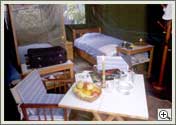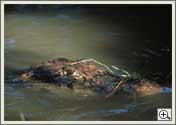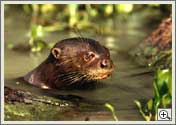Note: We require minimum two passengers traveling together If single traveler ask for the supplement.
In this vast area we find 1,000 of the globe’s 10,000 bird species (200 more than all of the U.S. and Canada combined), 15,000 of the world’s 250,000 flowering plant species, and hundreds of Jaguars. To put all of this in conservation perspective, this protected area is TWICE AS LARGE as all Costa Rican reserves—in fact, fully half the size of ALL of Costa Rica.
Manu National Park with Tapir & Macaw Clay Licks
Out Colorado – Puerto Maldonado – Cusco by commercial flight
Manu Cloud forest, Manu National Park and Manu Wildlife Center
7 days/6 nights
This is one of the most fascinating nature trips in the world. Our overland route crosses an extraordinary range of life zones from highlands to lowlands, taking us through an array of ecosystems found nowhere else on the planet in such close proximity. We see high altitude farming valleys and traverse stark highland puna, plunge through layers of grassland, elfin forest, layers of lush, ever-changing cloud forest, and then lowland tropical valleys where farmers cultivate coca and exotic fruits. All the way we traverse the habitat of innumerable bird species. Then our journey winds its way by river through lowland rainforest, taking us to a remote jungle village, then to a tented camp in the heart of Manu, the Upper Amazon basin’s greatest national park, and finally to the comfort of the Amazon’s finest wildlife lodge.
Only 20% of the entire Amazon has rich, floodplain soils that produce high yields of rainforest fruits, and therefore support dense populations of monkeys, macaws, and all other vertebrates and invertebrates. Of this 20%, ONLY ONE PERCENT is both protected by biological reserves AND has regular jet or turboprop flights. Manu Wildlife Center is the finest lodge in that “one percent of 20%” – which explains why Condé Nast Traveler Magazine found it to be “the most intense wildlife experience in Amazonia”.
Manu National Park, Amarakaeri Communal Reserve, Manu Wildlife Center Private Reserve, and Los Amigos Private Reserve comprise a single, continuous complex of protected areas in Manu province —the best protected section of the one percent of the 20%. The oldest of these units, Manu National Park, boasts the coveted status of UNESCO World Heritage Site. The entire complex covers 2.5 million hectares/6.2 million acres, almost the size of Belgium or the U.S. state of Maryland. The region includes vast areas inhabitated only by either uncontacted tribes or a handful of intrepid scientists.
In this vast area we find 1,000 of the globe’s 10,000 bird species (200 more than all of the U.S. and Canada combined), 15,000 of the world’s 250,000 flowering plant species, and hundreds of Jaguars. To put all of this in conservation perspective, this protected area is TWICE AS LARGE as all Costa Rican reserves —in fact, fully half the size of ALL of Costa Rica.
In Manu we navigate the waters of an isolated oxbow lake, home to giant otters, caimans, monkeys and an endless variety of birds.
Our trip ends downriver with the Amazon’s finest wildlife viewing opportunities, at Manu Wildlife Center. This lodge offers the finest Tapir viewing in ALL the Amazon, as Tapirs are nightly visitors to the lodge’s mud wallow. The mornings feature clay licks and fruiting trees teeming with parrots and macaws. A network of trails, two towers for forest canopy viewing, and two adjacent pristine lakes round out the perfect rainforest experience.
After a short canoe journey we return to Cusco aboard a modern, commercial airplane.
| Duration | 7 days and 6 nights |
| Departures | Tuesday |
| Activities | Jungle excursion (see detailed program below) |
| Meals | included as specified below |
| Customizable | YES, feel free to ask for extra services |
DAY 1: CUSCO TO COCK-OF-THE-ROCK LODGE.
Our overland journey begins at 3,400 m/11,150 ft, with an early departure from the highland city of Cusco. Today’s destination is the lush cloud forest region where the Andes fall away to the Amazon basin. This is a day of scenic drama and striking contrasts. We first visit a mountain wetland habitat teeming with migrant and local waterfowl, before crossing two mountain ranges between the Cusco valley and the Paucartambo valley, to a maximum altitude of 3,900 m/12,790 ft. Finally we follow a sinuous ribbon of highway on its plunge through an extraordinary world of forested cliffs, waterfalls and gorges. We take leisurely stops to see mountain villages, a hilltop necropolis of chullpas (pre-Inca burial chambers), and the abrupt ridgetop of Ajanaco, which marks the final high point where the Andes begin their swoop into the Amazon basin. In clear weather we will see a breathtaking panorama of cloud forest and mountain giving way to the lowland rainforest plains far below us.
After a picnic lunch near here we descend through the startling and rapid environmental transformations characteristic of the tropical Andes, passing from grassland and stunted trees through elfin forest, until we wind through a lush and magical world of overhanging trees, giant ferns, monster begonias, countless orchids and bromeliads, and a diverse and teeming birdlife.
We make frequent spontaneous stops, perhaps spotting a brilliantly feathered quetzal, a trogon, or the wild turkey-like Guan. We reach the comfortable Cock-of-the-Rock Lodge in the late afternoon, the best hour to visit the nearby viewing platform for the display ground, or “lek”. This is usually the highlight of a long, full day, a chance to see Peru’s dazzling national bird, the Cock-of-the-Rock (Rupicola) in full, raucous courting display. (Box Lunch, D).
DAY 2: COCK-OF-THE-ROCK LODGE TO BOCA MANU
Rising early, we have a second chance to view the Cock-of-the-Rock display, and then scout for birds, and perhaps Brown Capuchin or Woolly monkeys along the nearby road. Or we can take a secluded nature walk on a short trail loop to the river and back. After breakfast we continue our drive, as mountains give way to low rolling hills and farmland. At Patria we visit a plantation of coca grown legitimately for the Peruvian coca leaf market. At midday we reach Atalaya, a tiny port where the Piñipiñi River meets the Alto Madre de Dios. Now the lowland rainforest part of our journey begins. Rivers are the highways of the rainforest, and henceforth we will travel in large, comfortable dugout canoes shaded by canopy roofs and driven by powerful outboard motors.
As we follow the river’s broad, rushing course past the last foothills of the Andes, our ever-changing route offers sightings of new birds —terns, cormorants, White-winged Swallows, and flocks of nighthawks flushed from their daytime lairs by the sound of our engine.
Splashes of brilliant yellow, pink and red foliage dot the forest-clad slopes around us, and the breeze is laden with the heady perfumes of the tropical forest.
At our overnight lodge near Boca Manu, a new array of forest sounds awaits our ears. As night falls the whistling call-and-response of tinamous gives way to the loud shrill of cicadas. (B, Box Lunch, D)
DAY 3: BOCA MANU TO MANU NATIONAL PARK (MANU WILDLIFE TENTED CAMP).
In the morning we may join other eco-guests arriving by air from Cusco. We make a short visit to the village of Boca Manu, riverside capital of the remote and sparsely populated Peruvian province of Fitzcarrald. The main activity here is building dugout boats for travelers on the river, and we see how these sturdy craft are made. Logging is prohibited here, so the resourceful villagers work entirely with lumber brought downriver by floodwaters.
Now we turn northward up the chocolate-brown waters of the Manu River into the lake-rich lower Manu National Park. The pristine quality of the forest is instantly apparent, with abundant birdlife and no signs of outside development.
We check into the park at Limonal ranger station and then proceed upstream, as our boat driver steers skillfully through shallows and driftwood snags. Orinoco Geese and Horned Screamers strut on the beaches, Capped and White-necked Herons patrol the shoreline, and countless sunbathing turtles dive off their log perches as we approach.
After some six hours on the river we reach InkaNatura’s Manu Tented Camp, a simple but comfortable low-impact lodge nestled almost invisibly in the forest.
Time permitting, we will take a short walk before dinner to stretch our legs and enjoy our first encounter with virgin rainforest. (B, Box Lunch, D)
DAY 4: MANU NATIONAL PARK (MANU WILDLIFE TENTED CAMP): COCHA SALVADOR & COCHA OTORONGO.
Today we visit two lakes near our camp. Park authorities determine the time of our visit to Cocha (Lake) Salvador; depending on this schedule, we will visit Cocha Otorongo earlier or later in the day.
Our trail to Cocha Otorongo begins some 30 minutes downstream from the camp. This brief river journey to the trailhead can always offer the chance of a thrilling wildlife sighting. Perhaps we will spot a family of Capybaras, the world’s largest rodent, browsing on the riverbank, or if we are very lucky, a solitary Jaguar might stalk slowly off an open beach into the forest, flicking its tail in annoyance at our intrusion.
On the short trail to the lake we may spy one or more of the park’s 13 monkey species leaping through the canopy high above. And some of the trees which form that canopy —such as kapok, ironwood and figs, will astound us with the vast size of their trunks and buttressed root systems.
These are oxbow lakes, formed when the river changed course, leaving a landlocked channel behind. The lakes are abundant in fish and wildlife, and provide optimum habitat for caimans and the Giant Otter (Pteronura brasiliensis), one of the Amazon’s most endangered mammal species.
This lake enjoys maximum protection, and boats are not allowed. However, it features two dock platforms and a 50ft tower from which to scan the trees and marshy shoreline for monkeys, kingfishers, Anhinga (a large, long-necked waterbird), and countless other species. We have a good chance of sighting the resident Giant Otter family as they dive for the 4Kg. of fish that each individual consumes daily.
Cocha Salvador is the largest of the area’s lakes, at 3.5 Km, or some two miles long. It is also home to a family of Giant Otters. We cruise the lake on a floating catamaran platform, which offers superb new perspectives of lake and forest. The lakeside trees are often alive with monkeys; Scarlet, Chesnut-fronted and Blue-and-gold macaws beat a path overhead; a variety of herons and egrets scout the water’s edge; and the reptilian eyes and snouts of caimans, motionless as logs, may be spied beneath the branches. Somewhere on the open water or in among toppled bankside trees, we may spot the sleek heads of the shy Giant Otters. These social animals play and fish together, and we may see them sprawled on a fallen tree trunk, dozing or gnawing on a fish. (B, L, D)
DAY 5: MANU NATIONAL PARK (MANU WILDLIFE TENTED CAMP) TO MANU WILDLIFE CENTER AND TAPIR CLAY LICK.
We set off downriver at dawn. At this hour chances of wildlife encounters are excellent. We return to the Limonal park station, to file our wildlife report before leaving the park. After reaching the turbulent union of the Alto Madre de Dios and Manu rivers and then the village of Boca Manu, we may drop off some passengers returning to Cusco. After ninety more minutes downstream we arrive at Manu Wildlife Center —the exciting final stop of our journey— in time for lunch.
After an early afternoon rest we set off along the “collpa trail”, which will take us to the lodge’s famous Tapir Clay Lick. Here at the most active tapir lick known in all the Amazon, our research has identified from 8-12 individual 600-pound Tapirs who come to this lick to eat clay from under the tree roots around the edge. This unlikely snack absorbs and neutralizes toxins in the vegetarian diet of the Tapir, the largest land animal of Latin America. The lick features a roomy, elevated observation platform 5 m/17 ft above the forest floor. The platform is equipped with freshly-made-up mattresses with pillows. Each mattress is covered by a roomy mosquito net. The 10-m-long, elevated walkway to the platform is covered with sound-absorbing padding to prevent our footsteps from making noise. This Tapir Experience is unique and exciting because these normally very shy creatures are visible up close, and flash photography is not just permitted, but encouraged.
The hard part for modern city dwellers is to remain still and silent anywhere from 30 minutes to two or more hours. Many prefer to nap until the first Tapir arrives, at which point your guide gently awakens you to watch the Tapir 10-20 m/33-66 ft) away below the platform. Most people feel that the wait is well worth it in order to have such a high probability of observing the rare and elusive Tapir in its rainforest home. (B, L, D)
DAY 6: MANU WILDLIFE CENTER: THE MACAW CLAY LICK & COCHA BLANCO.
Another early start (inevitable on wildlife expeditions), is followed by a short boat ride downstream. We take a 20-minute trail through palm plantations to a cut off channel of the river, where we find the Macaw Lick. A spacious hide provided with individual chairs and a convenient place for cameras and binoculars is our ringside seat for what is usually a very spectacular show. We enjoy a full breakfast here while waiting for the main actors to arrive.
In groups of twos and threes the big Red-and-Green Macaws come flapping in, landing in the treetops as they eye the main stage below — the eroded clay banks of the old channel. Meanwhile the supporting cast appears: these may included Blue-headed, Mealy, Yellow-crowned, and Orange-cheeked Parrots — and the occasional villain, a menacing and unwelcome Great Black Hawk.
The drama plays out in first in tentative and then bolder approaches to the lick, until finally nearly all the macaws, parrots and parakeets form a colorful and noisy spectacle on the bare banks, squabbling as they scrape clay from the hard surface.
(Please note that the clay lick is most active from August to October and less so during the months of May and June.)
In the afternoon we visit Cocha Blanco, an old oxbow lake full of water lilies and sunken logs. As we circle the lake on our catamaran we might encounter the resident Giant Otter family on a fishing expedition, or troops of monkeys crashing noisily through the trees. Wattled Jacanas step lightly on the lily pads, dainty Sun Grebes paddle across the water, supple-necked Anhingas air-dry their wide, black wings, and perhaps an Osprey scans for fish from a high branch.
The bushes near the waterline, Hoatzins, which look like rust-colored, punk chickens, announce their presence with distinctive, bizarre wheezing and grunts. Woodpeckers, tanagers, macaws, toucans and parakeets all finally come swooping in to trees surrounding the lake. Many of them roost around the lake for the night. (B, L, D)
DAY 7: MANU WILDLIFE CENTER TO CUSCO – DEPARTURE DAY
We leave our lodge very early on the two hour and half return boat trip downstream to the Colorado Village, the breakfast will be serve on the boat while you enjoying early morning wildlife activity as we go, of course this is a perfect time to take advantage of valuable early morning wildlife activity along the river, in additions this journey allows us to see several lowland native settlements and gold miners digging and panning gold along the banks of the Madre de Dios River. We will stop in the far-west type gold-mining town of Colorado to start our overland journey to Puerto Carlos for 45 minutes, then you will cross the Inambari River for 15 minutes boat trip to Santa Rosa, finally a van or bus will drive us to the airport in Puerto Maldonado City, in approximately two-hours and half, from here you fly by a commercial airplane to Cusco or Lima (airfares not included)(B)
Important note:
Please note that the program may vary slightly so as to maximize your wildlife sightings, depending on the reports of our researchers and experienced naturalist guides based at the lodge.
END OF OUR SEVICES



WOULD YOU LIKE TO BOOK THIS TOUR ? ASK FOR AVAILABILITY
INCLUDES:
All hotel and lodge accommodations based on double or single occupancy. All scheduled land, lake and river transportation. All transfers. All scheduled excursions with English-speaking guide services. All entrance fees. Meals as specified in the itinerary. B=Breakfast; L=Lunch; D=Dinner.
NOT INCLUDED IN THE FEE
International or domestic airfares, airport departure taxes or visa fees, excess baggage charges, additional nights during the trip due to flight cancellations, alcoholic and non-alcoholic beverages or bottled water, snacks, insurance of any kind, laundry, phone calls, radio calls or messages, reconfirmation of international flights and items of personal nature.




